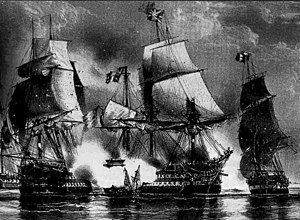Battle of Cape Noli
| Naval Battle of Genoa | |||||||
|---|---|---|---|---|---|---|---|
| Part of the French Revolutionary War | |||||||
 Ça Ira fighting |
|||||||
|
|||||||
| Belligerents | |||||||
|
|
|
||||||
| Commanders and leaders | |||||||
| Rear Admiral Pierre Martin | Vice Admiral Hotham | ||||||
| Strength | |||||||
| 13 ships of the line 490 guns 9,520 men |
14 ships of the line 557 guns 8,810 men |
||||||
| Casualties and losses | |||||||
| 600 killed 1,000 wounded 2 ships of the line |
74 killed 254 wounded |
||||||
The Battle of Genoa was a naval battle fought on 14 March 1795 off the coast of Genoa, a port city in north-western Italy, between French warships under Rear-Admiral Pierre Martin and British and Neapolitan warships under Vice Admiral William Hotham. The battle ended in a British-Neapolitan victory over the French and the capture of the French ships Ça Ira and Censeur by the British.
In early 1795 Vice-Admiral Hotham, the commander in chief of the Mediterranean Fleet, shifted his fleet from San Fiorenzo Bay, Corsica, to Leghorn, news which soon reached the French naval base at Toulon. A fleet of fifteen ships of the line, six frigates and two brig-corvettes was prepared, put to sea on 2 March 1795 under the command of Rear-Admiral Pierre Martin. Its objective was unclear: a fleet of transports had embarked 5,000 troops to invade Corsica and recapture it from the British, but these transports never departed Toulon. The report of the Committee of Public Safety to the National Convention states that the fleet was at sea to secure shipping lines in the Mediterranean.
Their progress was hampered by a series of north-easterly gales, but they came in sight of the island by early morning on 7 March, when the fleet's advanced figures discovered a British warship sailing under a jury rig. This was the 74-gun HMS Berwick, which had been refitting in San Fiorenzo Bay with the rest of the fleet in early 1795, when her lower masts, stripped of rigging, rolled over the side and were lost. A court-martial found that the proper precautions to secure the masts had not been taken and dismissed Berwick's captain, William Smith, her first lieutenant, and her master from the ship. Hotham had then sailed with his fleet, ordering Berwick's new captain, Adam Littlejohn, to fit a jury rig and then sail to join him at Leghorn. Littlejohn soon realised that the approaching fleet was a French one, despite their flying Spanish flags, and attempted to escape. With Berwick's speed greatly reduced to the jury-rig, the French frigates were able to close on the British ship, and at 11 am Alceste passed to leeward and opened fire within musket-shot on Berwick's lee bow. The Minerve and Vestale then hauled within range and took up position on Berwick's quarter. By noon, her rigging was cut to pieces and every sail was in ribbons. During the battle four sailors were wounded and a bar-shot decapitated Littlejohn; he was the only man killed. Command then devolved upon Lieutenant Nesbit Palmer, who consulted with the other officers. Palmer decided that as Berwick was unable to escape in her disabled state and that all further resistance was useless; he then ordered that Berwick strike her colours.Alceste had suffered casualties of eight men wounded, including her captain and another officer. Upon surrendering the British officers and crew were dispersed into the French ships.
...
Wikipedia
